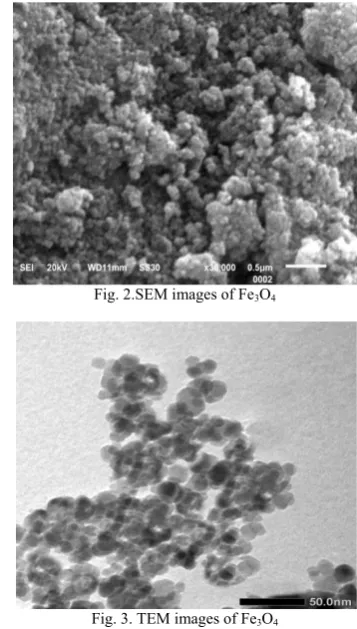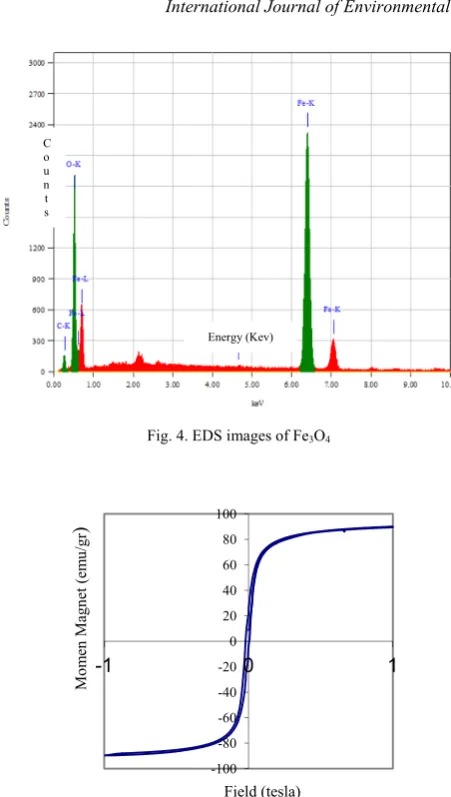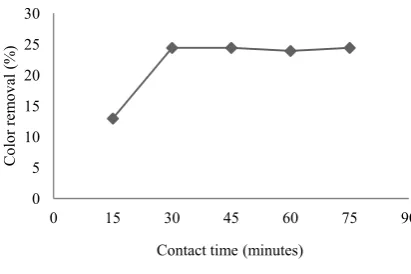Abstract—Fe3O4 (magnetite) nanoparticles were synthesized by chemical co-precipitation method. The structure, morphology and magnetic properties of as-prepared were characterized by X Ray Diffraction (XRD), Scanning Electron Microscope-Energy Dispersive X Ray Spectrometry (SEM-EDS), Transmission Electron Microscope (TEM) and Vibrating Sample Magnetometer (VSM). The result of XRD characterization was indicated Fe3O4 as the product. SEM and
TEM image of the Fe3O4 showed nanoparticles Fe3O4 have the
mean diameter 5-20 nm. The EDS spectra showed strong peaks of Fe and O. Magnetic characteristic of Fe3O4 nanoparticles was
indicated super paramagnetic properties. The saturation magnetic was 89.46 emu g-1. Therefore, the nanoparticles Fe3O4
is suitable to remove dye in the water by a simple magnetic separation process. The optimum adsorption occurred at initial concentration of procion dye 100 mg L-1, pH solution 6, dosage of Fe3O4 0.8 g L
-1
and contact time 30 minutes under room temperature with color removal 24.40 % and adsorption capacity was 30.503 mg g-1.
Index Terms—Fe3O4 nanoparticles, co-precipitation, adsorption, dye
I. INTRODUCTION
The magnetic nanoparticles have many uses such as magnetic drug target, magnetic resonance imaging forclinical diagnosis, recording material and catalyst, environment, etc [1]-[3]. Iron oxides nanoparticles play a major role in many areas of chemistry, physics and materials science. Fe3O4
(magnetite) is one of the magnetic nanoparticles. There are many various ways to prepare Fe3O4 nanoparticles, which
have been reported in other papers, such as energy milling [3], reducing [4], ultrasonic assisted impregnation [5], and using Tridax procumbens leaf extract [6]. Co-precipitation method is a method of synthesis of Fe3O4 which is easy to do with the
success rate from 96 to 99.9% [7]. In this method, ferrous and ferric ions at the ratio of 1 to 2 in alkaline medium. Chemical co-precipitation can produced fine, stoichiometry particles of single and multi component metal oxides [8].
The application of magnetic technology to solve environmental problems has received considerable attention
Manuscript received February 5, 2013; revised March 28, 2013. This work was supported in part by the Competitive Research Sriwijaya University for financial support No 0366/UN9.4.2.1/LK/2011).
Poedji Loekitowati Hariani and Muhammad Faizal are with the Chemistry Department, University of Sriwijaya, Palembang, Indonesia (email: [email protected]; [email protected]).
Ridwan is with the National Nuclear Energy Agency, Tangerang Selatan 15314, Indonesia (email: [email protected])
Marsi is with Agrotechnology Department, University of Sriwijaya, Palembang 30139, Indonesia (email: [email protected]).
Dedi Setiabudidaya is with the Physics Department, University of Sriwijaya, Palembang 30139, Indonesia (email: [email protected]).
in recent years. Many of papers have been published demonstrating that magnetic Fe3O4 can be used for
wastewater purification, such as to adsorb arsenite, arsenate, crom, cadmium, nickel [9],[10]. Fe3O4 also can be used to
alkalinity and hardness removal, desalination, decolorisation of pulp mill effluent and removal of natural organic compounds [3]. After adsorption, Fe3O4 can be separated
from the medium by a simple magnetic process. Thus, an efficient, economic, scalable, and non toxic. Synthesis of Fe3O4 nanoparticles is highly preferred for potential
application and fundamental research [11],[12].
In current study, Fe3O4 will be used to adsorb dye.
Removal of dyes from wastewater is a major environmental problem because dyes are visible even at low concentration. The existence of highly colored waste is not only aesthetically disturbance, but it also impedes light penetration, thus up setting biological process within a stream, some dyes also being toxic or carcinogenic [13]. It is estimated that 10-50 % of the dye is lost in the effluent [14]. Therefore, the treatment of effluent containing such a dye is a interest due to its harmful impacts on receiving waters [15].
The objective of this study were to synthesis Fe3O4 by
co-precipitation methods and assess the ability of Fe3O4 to
remove procion dye. The procion dye including azo dyes which have -N=N- bond. Additionally procion dyes have two of aromatic group and one atom sodium. These dye are used in the textile industrial for dyeing process. Various techniques for removing dyes from effluents have been developed, including electrochemical treatment, sonochemical treatment, photo catalytic oxidation and adsorption. Adsorption method is a promising and attractive alternative for treatment of azo containing effluents if adsorbents used are inexpensive and readily available [12], [14], [15].
II. MATERIAL AND METHODS
A. Materials
All the reagents used for the synthesis Fe3O4 were
analytical grade and used without further purification. Ferric chloride [FeCl3], ferrous chloride [FeCl2], sodium hydroxide
[NaOH] were purchased from Merck, Germany.
B. Synthesis Fe3O4
Synthesis of Fe3O4 magnetics nanoparticles were prepared
by co-precipitation of ferric and ferrous salts under the presence of N2 gas. 16.25 FeCl3 and 6.35 g of FeCl2 were
dissolve into 200 mL of deoxygenated distilled water. After stirring for 60 minutes, chemical precipitation was achieved at 300C under vigorous stirring by adding of 2 M NaOH solution under presence of N2 gas. The reaction system keep
Synthesis and Properties of Fe
3
O
4
Nanoparticles by
Co-precipitation Method to Removal Procion Dye
at 700C for 5 h and pH solution ± 12. Completed precipitation of Fe3O4 expected at pH between 8 and 14 [16]. After the
system was cooled to room temperature, the precipitates were separated by a permanent magnet and washed with deoxygenated distilled water until pH neutral. Finally Fe3O4
washed with acetone and dried in oven at 60-700C. The relevant chemical reaction can be expressed as follows eq.1:
Fe2+ + 2Fe3+ + 8OH-→Fe3O4 + 4H2O (1) C. Characterizations of Materials.
The crystal structure of the products was characterized by X-ray Diffraction (XRD) Shimadzu XD-610. The patterns with the Cu Kα radiation (λ = 1,54051 Å) were recorded in the region of 2 range 10 to 800. The morphology of the Fe3O4 materials were examined by Scanning Electron
Microscope-Energy Dispersive X Ray Spectrometry (SEM-EDS) JEOL-JSM-6510 LV. Transmission Electron Microscope (TEM) JEOL JEM 1400 was used for characterizing the size of nanoparticles. The magnetic properties of the Fe3O4 materials measurement by Vibrating
Sample Magnetometers (VSM) Lakeshore 74004 at room temperature. Uv-Vis Spectrometry by Shimadzu 2550 used to measurement procion dye concentration.
D. Adsorption Experiment.
The studies of procion dye adsorption were performed by batch adsorption method. The adsorption experiments were conducted by varying initial concentration of procion dye from 25 to 150 mg L-1, pH solution was adjusted over the range pH 5-9 using HCl and NaOH 1 M, dosage of Fe3O4
from 0,5; 0,6; 0,7; 0,8; 0,9 and 1 g L-1 and contact time at 15, 30, 45, 60 and 75 minutes. Adsorption experiments were carried out with a thermostatic shaker at 120 rpm.
Adsorption data analysis. The concentration retained in color removal color ( ,%) and adsorption capacity for Fe3O4,
qe (mg g-1), was determined by analyzing procion dye before
and after the treatment and calculated by using the eq.2. and eq.3
% (2)
(3) where C0 and Ce are initial and equilibrium dye concentration
in the solution (mg L-1), m is the adsorbent dosage (mg), and V is the volume of the solution (mL).
III. RESULT AND DISCUSSION
A. Characteristic of the Fe3O4.
Fig. 1. shown XRD patterns of the Fe3O4. Six
characteristic peaks at 30,2050, 35,5150, 43,3250, 53,7110, 57,2150 and 62,9450 were corresponding to the (220), (311), (400), (422), (511) and (440) crystal planes of a pure Fe3O4
with a spinal structure (JCPDS file PDF no.65-3107) [17]. The peaks indicating that Fe3O4 with a spinal structure and no
characteristic peak of impurities are detected in the XRD pattern.
Fig. 1. XRD pattern for Fe3O4
In order to investigate the morphology of obtained materials by SEM and TEM images. Fig. 2. shown SEM image of Fe3O4, in the picture appears that Fe3O4 particles
composed of small particle. Fig. 3. shown the TEM image of Fe3O4, from which we can know that the diameter size 5-20
nm. Fe3O4 synthesized by co-precipitation with different
reagen (FeCl3.6H2O, FeCl2.4H2O, propylene glycol and
ammonium hydroxide) indicated the mean size of particles was 8 nm [18]. The control of the monodisperse size is very important because the properties of nano crystal strongly depend upon the dimension of nanoparticles [16].
Fig. 2.SEM images of Fe3O4
Fig. 3. TEM images of Fe3O4
Characterization of Fe3O4 using EDS in Fig. 4. The EDS
spectra showed the strong peaks of Fe and O. The composition components of Fe3O4 formed by co-precipitation
synthesis Fe was 73.36% and O was 21.02%. These results demonstrate the purity of the synthesis results.
0 10 20 30 40 50 60 70 80 90
0 10 20 30 40 50 60 70 80 90
Intensity
Fig. 4. EDS images of Fe3O4
Fig. 5. Saturation Magnetization of Fe3O4
Fig. 5 shows the magnetization curve of Fe3O4 obtained by
VSM at 250C. The saturation magnetization of Fe3O4
nanoparticles was 89.46 emu g-1. The magnetization of Fe3O4
is not far from the actual magnetization of the Fe3O4 is 92
emu g-1 [19]. The excellent magnetic responsivity was necessary for magnetic separation from dye-containing effluents in the future.
B. Optimum Condition Adsorption
The effect of initial concentration of procion dye on the adsorption properties shows in Fig. 6. The increase of color removal has positive comparison with the increase of initial concentration of procion dye.It was clear that the adsorption process dependent on initial procion dye concentration. The large number of vacant surface sites were available for adsorption during initial stage. Initial concentration of procion dye on the adsorption process is then used at a concentration of 100 mg L-1
The pH of dye solution plays an important role in the whole adsorption process and particularly on the color removal. The most color removal was 25.19 % at pH solution 5. The dye with two sulfonic groups ionized easily even in acidic media and became a soluble anion dye. Anion dye and neutral solutions were easily adsorbed to Fe3O4 with
positive surface charge [20]. All the adsorption was highly pH dependent. The optimal pH for the removal of Cr(VI), Cu(II) and Ni(II) were 2.5, 6.5 and 8.5 by maghemite nanoparticles. Under the optimal pH , their uptakes mainly
resulted from electrostatic attraction [21]. The color removal of procion dye at pH 6 which is 24.40 %, no thighly different from th pH 5 shown in Fig. 7. Thus, in the adsorption process used at pH 6 because it closer to neutral pH solution.
Fig. 6. Effect initial concentration of procion dye
Fig. 7. Effect pH solution procion dye
Fig. 8 shows effect of dosage Fe3O4 and contact time to
adsorb procion dye. The corresponding result showed that an increased in adsorbent dosage could increase adsorption capacity. With increasing adsorbent dosage, more surface area was available for adsorption due to the increase in active site on the surface Fe3O4 and thus making easier penetration
of adsorbate to adsorption. The dosage Fe3O4 to adsorb
procion dye at a fixed of 0.8 g L-1.
Fig. 8. Effect dosage Fe3O4
Effect contact time, color removal also increased with increasing contact time shown in Fig. 9. The equilibrium time at 30 minutes and after equilibrium time the color removal was stable. In the optimum condition adsorption has color removal was 24.40 % . This condition color removal is optimum so that extra time does not increase the color removal.
Initial concentration procion dye (mg/L)
Fig. 9. Effect contact time
The adsorption capacity at the equilibrium time was 30.503 mg g-1. The adsorption capacity of Fe3O4
nanoparticles is greater than adsorption capacity of iron oxide/carbon nanotube nanocomposite for removal methylene blue. It was reported 20 mg g-1 at the equilibrium time 20 minutes [22].
IV. CONCLUSIONS
Fe3O4 nanoparticles were synthesized by chemical
co-precipitation method have the diameter 5-20 nm and the saturation magnetic was 89.46 emu g-1, which indicated super paramagnetic properties. The nanoparticles Fe3O4 is suitable
to remove dye in the water by a simple magnetic separation process. The optimum adsorption occurred at initial concentration of procion dye 100 mg L-1, pH solution was 6, dosage of Fe3O4 0.8 g L-1 and contact time 30 minutes
adsorption capacity was 30.503 mg g-1.
ACKNOWLEDGMENT
The Author thanks to the Sriwijaya University for proving a suciffient amount of Competitive Research Sriwijaya University for financial support No 0366/UN9.4.2.1/LK/2011).
REFERENCE
[1] U. Hafeli, W. Schutt, J. Teller, and M. Zborowski, Scientific and
Clinical Applications of Magnetic Microspheres, Plenum, New York, pp. 324-326, 1997.
[2] V. S. Zaitsev, D. S. Filimonov, I. A. Presnyakov, R. J. Gambino, and B.
Chu, “Physical and Chemical Properties of Magnetite and Magnetite
Polymer Nanoparticles and Their Colloidal Dispersions,” Journal
Colloid Interface Sci., vol. 212, pp. 49-57, 1999
[3] B. A. Bolto, “Magnetic Particle Technology for Wastewater
Treatment,” Waste Management, vol. 10, pp. 11-21, 1990
[4] A. B. Fuertes and P. Tartaj, “A Facile Route for the Preparation of
Superparamagnetic Porous Carbon,” Chem. Mater, vol. 18, pp.
1675-1679, 2008.
[5] T. Yang, S. H. Zhu, D. Zhang, and S. H. Xu, “Synthesis and properties
of magnetic Fe3O4-Activated Carbon Nanocomposite Particles for Dye
Removal,” Mater. Lett., vol. 62, pp. 645-647, 2008.
[6] M. Senthil and C. Ramesh, “Biogenic Syhthesis of Fe3O4
Nanoparticles using Tridax Procumbens leaf Extract and Its
Antibacterial Activity on Pseudomonas Aeruginosa,” Journal of
Nanomaterials and Biostructures, vol. 7, no. 3, pp. 1655-1660, 2012.
[7] S. Liong, “A Multifunctional Approach to Development, Fabrications
and Characterizations of Fe3O4 Composite,” Georgia Institut of
Technology, North Ave, Atlanta, Georgia, pp. 213-217, 2005.
[8] S. E. Kentish and G. W. Stevens, “Innovation in Separations
Technology for the Recycling and Re-use of Liquid Waste Streams,” J.
Chem. Eng., vol. 84, pp. 149-159, 2001.
[9] J. T. Mayo, et al., “The Effect of Nano Crystalline Magnetite Size on
Arsenic Removal,” Journal of Science and Technology Materials, vol.
8, pp. 71-75, 2008
[10] F. Rosada, M. Otero, A. Moran, and A. I. Garcia, “Adsorption of
Heavy Metals onto Sewage Sludge-Derived Materials,” Bioresour
Technology, vol. 99, pp. 6332-6338, 2008.
[11] S. H. Sun and H. Zeng, “Size Controlled Synthesis of Magnetite
Nanoparticles,” Journal Am.Chem.Soc., vol. 24, pp. 8204-8205, 2002.
[12] S. R. Wan, J. S. Huang, H. S. Yan, and K. L, Liu, “Size controlled
preparation of magnetite nanoparticles in the presence of graft
copolymer,” Journal Mater.Chem., vol. 16, pp. 298-303, 2006.
[13] S. Wang, Y. Boyjoo, A. Choueib, and H. Zhu, “Removal of Dye from
Solution using Fly Ash and Red. Mud,” Water Research, vol. 39, pp.
29-38, 2005.
[14] S. Senthilkumaar, P. Kalaamani, K. P. R. Varadarajan, and S. V.
Subburaam, “Adsorption of dissolved reactive red dye from aqueous phase onto activated carbon prepared from agricultural waste,” Bioresour. Technology, vol. 97, pp. 1618-1625, 2006.
[15] I. A. W. Tan and B. H. Hameed, “Adsorption isotherm, kinetics,
thermodynamics and desorption studies of basic dye on activated
carbon derived from oil palm empty bunch,” Journal of Applied
Science, vol. 10, no. 21, pp. 2565-2671, 2010.
[16] L. Sophie, F. Delphine, P. Marc, R. Alain, R. Caroline, V. E. Luce, and
N. M. Robert, “Magnetic iron oxide nanoparticles: synthesis, stabilization, vectorization, physicochemical characterization, and
biological applications,” Chem. Rev., vol. 108, pp.2064-2110, 2008.
[17] G. L. Li, Y. R. Jiang, K. L. Huang, P. Ding, and I. I. Yao,” Kinetics of
adsorption of sacharomyces cereviceae mandelated dehydrogenase on
magnetic Fe3O4-chitosan nanoparticles,” Journal Colloid Interface Sci.,
vol. A 320, pp 11-18, 2008.
[18] Y. F. Shen, J. Tang, Z. H. Nie, Y. D. Wang, Y. Ren, and L. Zuo,
“Preparation and application of magnetic nanoparticles fe3o4 for water
purification,” Separation and Purification Technology, vol. 68, pp.
312-319, 2009.
[19] H. M. Lu, W. T. Zheng, and Q. Jiang, “Saturation magnetization of
ferromagnetic and ferrymagnetic nanocrystal at room temperature,” Journal of Phys. D. Appl.Phys., vol. 40, pp. 320-325, 2007.
[20] H. Y. Zhu, Y. Q. Fu, R. Jiang, L. Xiao, G. M. Zeng, S. L. Zhao, and Y.
Wang, “Adsorption removal of congo red onto magnetic
cellulose/Fe3O4/activated carbon composite: equilibrium, kinetic, and
thermodynamic studies,” Chemical Engineering Journal, vol. 173, pp
494-502, 2011.
[21] J. Hu, G. H. Chen, and I. M.C. Lo, “Removal and recovery of Cr(VI)
from wastewater by maghemite nanoparticles”, Water. Res., vol. 39, pp.
4528-4538, 2005.
[22] T. Pankay and A. J. Pattayil, “Superparamagnetic nanocompocite of
magnetite and activated carbon for removal dyes from wastewater,” Nanoscience and Nanotechnology Letters, vol. 1, pp. 171-175, 2009.
Poedji Loekitowati Hariani was born in Madiun, Indonesia, on August 27, 1968. In 1992 graduated with a scholar science in Chemistry Department, Gadjah Mada University, Indonesia. In 1997 graduated from master of scince, field of environmental chemistry at the Institute of Technology Bandung, Indonesia. At this time, she is study doctoral in the field of environmental scince at Sriwijaya University, Indonesia. She works has a lecturer in the Chemistry Department, Faculty of Mathematics and Science, Sriwijaya University, Palembang, Indonesia. Research carried out for this focus wastewater treatment.
Ridwan was born in Prabumulih City, Indonesia, on 28 Juny 1959. Doctor of Science on Solid State Physics from Kyoto University. At this time, Ridwan is a professor in the field physics material and work at National Nuclear Energy Agency, Tangerang Selatan 15314, Indonesia. Currently, Prof. Dr. Ridwan is a member of Indo-Asean Magnetic Material.
Marsi was born at Petanggan, East OKU, South
Sumatra, Indonesia on July 14th, 1960. He was
graduated from Bogor Agricultural University, Indonesia for his Bachelor Degree in field of Soil Science in 1983. He got his Master Degree in 1989 and Ph.D Degree in 1992 both from University of Kentucky, USA, in field of soil chemistry. He has worked as a lecturer at Soil Science Department, Faculty of Agriculture, Sriwijaya University since 1985. He is interested in soil chemistry of swampy land for his focus research since one-third of South Sumatera area was covered by swampy land. Currently, Dr. Marsi is a member of Indonesian Soil Science Society.


